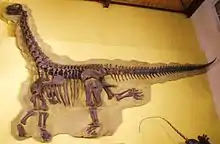Cathetosaurus
Cathetosaurus (meaning "upright lizard", referring to a possible ability to rear on its hind legs[1]) is a genus of sauropod dinosaur named from remains found in the United States. It contains one species: Cathetosaurus lewisi[2] that was once thought to be within the genus Camarasaurus. The holotype specimen was originally described by James Jensen and is now in the Brigham Young University collection.
| Cathetosaurus | |
|---|---|
 | |
| Referred specimen SMA 0002 | |
| Scientific classification | |
| Kingdom: | Animalia |
| Phylum: | Chordata |
| Clade: | Dinosauria |
| Clade: | Saurischia |
| Suborder: | †Sauropodomorpha |
| Clade: | †Sauropoda |
| Clade: | †Eusauropoda |
| Clade: | †Neosauropoda |
| Clade: | †Macronaria |
| Clade: | †Camarasauridae |
| Genus: | †Cathetosaurus Jensen, 1988 |
| Type species | |
| †Cathetosaurus lewisi Jensen, 1988 | |
| Synonyms | |
| |
Description

Soft tissue from the mouth region of SMA 0002 made researchers propose in 2016 that the tooth crowns were covered by gingival tissue, and perhaps a keratinous beak.[3]
The diagnostic characters for Cathetosaurus are: the pelvis is rotated anteriorly, such that the pubis projects posteroventrally, and the ischium projects posteriorly (1), lateroventrally projecting spurs in the neural spines of the last dorsals (2); posterior cervical and anterior dorsal diapophyses bearing an anterior projection lateral to the prezygapophyses (3); frontals with anterior midline projection into the nasals (4); trapezoidal supraoccipital (more expanded dorsally than ventrally) (5); lateral spur on the dorsal part of the lacrimal (6); fenestrated pterygoid (7); and the large pineal foramen between the frontals (8). Because of this, the proportions of the genus are extremely unusual: it has a very large skull relative to the axial skeleton, the limbs are short relative to the axial skeleton, the ribcage is extremely deep, so that the bottom of the ribcage is below the knee level. These features, and the rotation of the pelvis provided larger belly volume to the species.[4]
Classification
The holotype specimen of Cathetosaurus lewisi is contemporary with the middle of the C. grandis age range. This species was later synonymized with Camarasaurus.[5] More recent research has split the two genera again, based on the recognition of a second specimen.[4]
References
- http://www.paleofile.com/Dinosaurs/Sauropoda/Camarasaurus.asp
- Jensen, J. A. (1988). "A fourth new sauropod dinosaur from the Upper Jurassic of the Colorado Plateau and sauropod bipedalism". Great Basin Naturalist. 48 (2): 121–145.
- Wiersma, K.; Sander, P. M. (2016). "The dentition of a well-preserved specimen of Camarasaurus sp.: implications for function, tooth replacement, soft part reconstruction, and food intake". PalZ. doi:10.1007/s12542-016-0332-6.
- Mateus, O., & Tschopp E. (2013). Cathetosaurus as a valid sauropod genus and comparisons with Camarasaurus. Journal of Vertebrate Paleontology, Program and Abstracts, 2013. 173.
- McIntosh, John, Stadtman, Kenneth; Gillette, David; Miller, Wade (1996). "The osteology of Camarasaurus lewisi (Jensen, 1988)". Brigham Young University Geology Studies. 41: 73–116.












